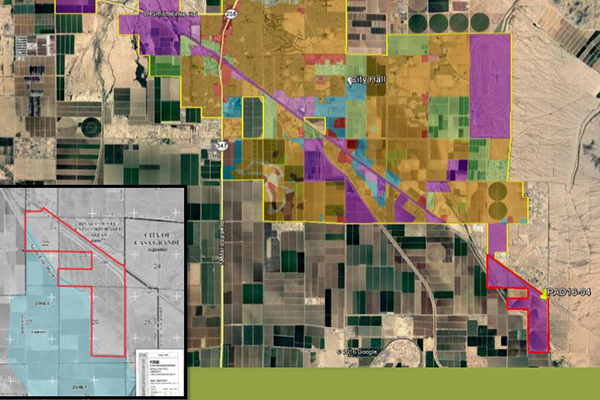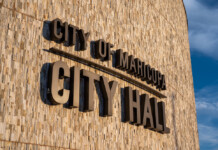
A cursory presentation delivered by city Development Services personnel to the Planning & Zoning Commission on Monday exposed concerns about the future development and annexation of a large parcel of land to the east of town.
The “high altitude” overview of the project raised questions among commissioners, who seemed worried about infrastructure installment costs and, above all else, about public safety.
Located at the nexus of Anderson Road and Maricopa-Casa Grande Highway south of the Ak-Chin Regional Airport, the 776-acre Anderson Russell Planned Area Development site is slated for the eventual development of 2,000-3,000 homes as part of the City’s 2040 Vision plan.
Commissioner Michael Sharpe, who at the same meeting was elevated to the position of vice chair, is one of several commissioners who expressed concerns over the project. He is worried about both the cost of infrastructure development and effects from the eventual widening of the highway.
“[It] requires investment in the necessary infrastructure, and that’s going to be difficult,” Sharpe said.
Sharpe asked if the city was “considering when Maricopa-Casa Grande Highway eventually gets expanded.”
Recently-appointed P&Z Chair Linda Huggins raised concerns about emergency situations that could arise due to the proximity of the airport and the subdivision’s distance from first responders.
“With this amount of area being developed, we definitely need to have the Transportation Department look at the egress and ingress,” Huggins said. “We can’t prevent first responders from being able to respond.”
Maricopa Police Chief Steve Stahl said he, too, is concerned about the implications of such obstacles. Though he believes in the city’s development, he said in its current state the MPD would be unable to properly serve the addition of so many homes.
“The way it sits right now there is a high probability that we would not be able to provide the appropriate amount of resources,” Stahl said, “both police and fire.”
Stahl also expressed concern about the isolated nature of the area.
Not only would it become inaccessible in the event of a flood, he said, but the railroad, which currently has trains traveling through Maricopa 40 or more times a day, could further isolate the subdivision, which would reside on the south side of the tracks with no current alternate access.
Development Services staff said they didn’t have all the answers to those questions and were giving only a loose overview of the proposal. A detailed report is due to come back to the commission at a future date.
If the commission decides to move forward with rezoning, public hearings will be held to allow for public input.





![Elena Trails releases home renderings An image of one of 56 elevation renderings submitted to Maricopa's planning department for the Elena Trails subdivison. The developer plans to construct 14 different floor plans, with four elevation styles per plan. [City of Maricopa]](https://www.inmaricopa.com/wp-content/uploads/2024/04/city-041724-elena-trails-rendering-218x150.jpg)
![Affordable apartments planned near ‘Restaurant Row’ A blue square highlights the area of the proposed affordable housing development and "Restaurant Row" sitting south of city hall and the Maricopa Police Department. Preliminary architectural drawings were not yet available. [City of Maricopa]](https://www.inmaricopa.com/wp-content/uploads/2024/04/041724-affordable-housing-project-restaurant-row-218x150.jpg)

![City looks to lower property taxes again City Manager Ben Bitter speaks during a Chamber of Commerce event at Global Water Resources on April 11, 2024. Bitter discussed the current state of economic development in Maricopa, as well as hinting at lowering property tax rates again. [Monica D. Spencer]](https://www.inmaricopa.com/wp-content/uploads/2024/04/spencer-041124-ben-bitter-chamber-property-taxes-web-218x150.jpg)



![Alleged car thief released without charges Phoenix police stop a stolen vehicle on April 20, 2024. [Facebook]](https://www.inmaricopa.com/wp-content/uploads/2024/04/IMG_5040-218x150.jpg)




